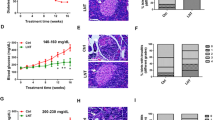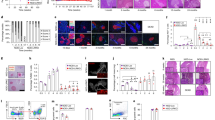Abstract
We have previously shown that systemic injection of multiple low doses of recombinant murine interleukin-4 (mIL-4) can prevent type 1 diabetes (T1D) in nonobese diabetic (NOD) mice by activating regulatory T helper (Th) 2 cells in vivo. Here, we have developed a gene transfer approach to the prevention of T1D by testing the therapeutic potential of an adenovirus gene transfer vector engineered to express mIL-4. We found that only two systemic injections of a recombinant adenovirus type 5 vector-expressing mIL-4 (Ad5mIL-4) reduces destructive insulitis and protects NOD mice from the onset of diabetes by eliciting intrapancreatic Th2 cell responses. Host immune responses against the adenovirus vector were detectable; however, the levels of antibody production were insufficient to preclude Ad5mIL-4 treatment as a possible therapeutic agent against T1D. Thus, adenovirus-mediated delivery of IL-4 provides protection of NOD mice from T1D and represents a clinically viable therapeutic approach.
This is a preview of subscription content, access via your institution
Access options
Subscribe to this journal
Receive 12 print issues and online access
$259.00 per year
only $21.58 per issue
Buy this article
- Purchase on Springer Link
- Instant access to full article PDF
Prices may be subject to local taxes which are calculated during checkout



Similar content being viewed by others
References
Delovitch TL, Singh B . The nonobese diabetic mouse as a model of autoimmune diabetes: immune dysregulation gets the NOD Immunity 1997 7: 727–738
Shehadeh NN, LaRosa F, Lafferty KJ . Altered cytokine activity in adjuvant inhibition of autoimmune diabetes J Autoimmun 1993 6: 291–300
Rabinovitch A et al. IFN-γ gene expression in pancreatic islet-infiltrating mononuclear cells correlates with autoimmune diabetes in nonobese diabetic mice J Immunol 1995 154: 4874–4882
Arreaza GA et al. Neonatal activation of CD28 signalingovercomes T cell anergy and prevents autoimmune diabetes by an IL-4-dependent mechanism J Clin Invest 1997 100: 2243–2253
Cameron MJ et al. IL-4 prevents insulitis and insulin-dependent diabetes mellitus in nonobese diabetic mice by potentiation of regulatory T helper-2 cell function J Immunol 1997 159: 4686–4692
Gallichan WS, Balasa B, Davies JD, Sarvetnick N . Pancreatic IL-4 expression results in islet-reactive Th2 cells that inhibit diabetogenic lymphocytes in the nonobese diabetic mouse J Immunol 1999 163: 1696–1703
Fox CJ, Danska JS . Independent genetic regulation of T-cell and antigen-presenting cell participation in autoimmune islet inflammation Diabetes 1998 47: 331–338
Pilstrom B, Bjork L, Bohme J . Demonstration of a Th1 cytokine profile in the late phase of NOD insulitis Cytokine 1995 7: 806–814
Rapoport MJ et al. Interleukin 4 reverses T cell proliferative unresponsiveness and prevents the onset of diabetes in nonobese diabetic mice J Exp Med 1993 178: 87–99
Aulitzky WE, Schuler M, Peschel C, Huber C . Interleukins. Clinical pharmacology and therapeutic use Drugs 1994 48: 667–677
Giannoukakis N, Rudert WA, Robbins PD, Trucco M . Targeting autoimmune diabetes with gene therapy Diabetes 1999 48: 2107–2121
Graham FL, Prevec L . Manipulation of adenovirus vectors. In: Murray EJ, Walker JM (eds) Methods in Molecular Biology. Gene Transfer and Expression Protocols Humana Press: Clifton, NJ 1991 pp 109–127
Parks E et al. Transient gene transfer of IL-12 regulates chemokine expression and disease severity in experimental arthritis J Immunol 1998 160: 4615–4619
Hogaboam CM et al. Therapeutic effects of interleukin-4 gene transfer in experimental inflammatory bowel disease J Clin Invest 1997 100: 2766–2776
Yasuda H et al. Local expression of immunoregulatory IL-12p40 gene prolonged syngeneic islet graft survival in diabetic NOD mice J Clin Invest 1998 102: 1807–1814
Giannoukakis N et al. Adenoviral gene transfer of the interleukin-1 receptor antagonist protein to human islets prevents IL-1β-induced beta-cell impairment and activation of islet cell apoptosis in vitro Diabetes 1999 48: 1730–1736
Ryan JJ . Interleukin-4 and its receptor: essential mediators of the allergic response J Allergy Clin Immunol 1997 99: 1–5
Swain SL . Generation and in vivo persistence of polarized Th1 and Th2 memory cells Immunity 1994 1: 543–552
Yeh P, Perricaudet M . Advances in adenoviral vectors: from genetic engineering to their biology FASEB J 1997 11: 615–623
Parks R, Evelegh C, Graham F . Use of helper-dependent adenoviral vectors of alternative serotypes permits repeat vector administration Gene Therapy 1999 6: 1565–1573
Fisher KJ et al. Recombinant adeno-associated virus for muscle directed gene therapy Nature Med 1997 3: 306–312
Gallichan WS et al. Lentivirus-mediated transduction of islet grafts with interleukin 4 results in sustained gene expression and protection from insulitis Hum Gene Ther 1998 9: 2717–2726
Hollon T . Researchers and regulators reflect on first gene therapy death Nature Med 2000 6: 6
Addison CL, Gauldie J, Muller WJ, Graham FL . An adenoviral vector expressing interleukin-4 modulates tumorigenicity and induces regression in a murine breast cancer model Int J Oncol 1995 7: 1253–1260
Bett AJ, Haddara W, Prevec L, Aham FL . An efficient and flexible system for construction of adenovirus vectors with insertions or deletions in early regions 1 and 3 Proc Natl Acad Sci USA 1994 19: 8802–8806
Lukacs NW et al. The role of macrophage inflammatory protein 1α in Schistosoma mansoni egg-induced granulomatous inflammation J Exp Med 1993 177: 1551–1559
Acknowledgements
We thank Dr Subrata Chakrabarti and Kollol Mukerjee for their assistance with the pancreas histology, Ms Carol Richardson and her staff for maintaining our mouse colony, Ms Anne Leaist for her cheerful assistance with the preparation of this manuscript, and all members of our laboratory for their advice and encouragement. Supported by grants from the Juvenile Diabetes Foundation International (JDFI), Medical Research Council (MRC) of Canada (MT-5729), MRC/JDFI Diabetes Centre of Excellence and Canadian Diabetes Association (CDA) (TLD), a postdoctoral fellowship from the CDA and Fundayacucho (Venezuela) (GAA), and a Doctoral Research Award from the MRC of Canada (MJC).
Author information
Authors and Affiliations
Rights and permissions
About this article
Cite this article
Cameron, M., Arreaza, G., Waldhauser, L. et al. Immunotherapy of spontaneous type 1 diabetes in nonobese diabetic mice by systemic interleukin-4 treatment employing adenovirus vector-mediated gene transfer. Gene Ther 7, 1840–1846 (2000). https://doi.org/10.1038/sj.gt.3301309
Received:
Accepted:
Published:
Issue Date:
DOI: https://doi.org/10.1038/sj.gt.3301309
Keywords
This article is cited by
-
Current Status on Immunological Therapies for Type 1 Diabetes Mellitus
Current Diabetes Reports (2019)
-
Emerging role of chemokine CC motif ligand 4 related mechanisms in diabetes mellitus and cardiovascular disease: friends or foes?
Cardiovascular Diabetology (2016)
-
Cationic Nanomicelles for Delivery of Plasmids Encoding Interleukin-4 and Interleukin-10 for Prevention of Autoimmune Diabetes in Mice
Pharmaceutical Research (2012)



